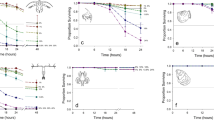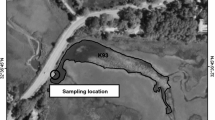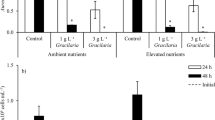Abstract
The response of the unarmored dinoflagellate Gymnodinium breve, which is the causative organism in catastrophic fish kills along the Florida Gulf coast, to enrichment with selected inorganic nutrients, municipal waste materials, and various detergent components has been determined. The biostimulatory effects of the various enrichments were determined by a modification of the Provisional Algal Assay Procedure of the Joint Industry/Government Task Force on Eutrophication. Inorganic nutrients (orthophosphate, nitrate, and ammonia) were added individually and in combination, and the results were compared to equivalent enrichments with the effluent from a secondary sewage-treatment plant. The maximum cell population, Nmax, attained could be increased 3-fold by the sew-age-treatment plant effluent or by the equivalent combination of inorganic nutrients; individually, however, the inorganic nutrients had no pronounced effect on maximum cell population, Nmax (except for a 30% increase produced by slight orthophosphate enrichment). The results of these studies indiccate that, at concentrations of orthophosphate typical of Florida coastal waters (ca. 0.10 ppm), the growth-promoting potential (as reflected by Nmax) of the medium was a linear function of the ammonia-nitrogen concentration (0.01 to 0.11 ppm). The sewage-treatment plant effluent was presumably low in detergent phosphate, having been obtained from a treatment plant some 6 months after the enactment of a ban on phosphate-containing detergents. Additions of orthophosphate or detergent-phosphate to the treatment-plant effluent did not significantly increase the observed biostimulatory effect of the waste material.
Similar content being viewed by others
Literature Cited
Aldrich, D. V.: Physiology of the Florida red tide organism. Circ. Fish Wildl. Serv., Wash. 92, 40–42 (1960).
Brydon, G. A., D. F. Martin and W. K. Olander: Laboratory culturing of the Florida red tide organism, Gymnodinium breve. Envir. Letters 1, p. 235 (1971).
Collier, A., W. B. Wilson and M. Borkowski: Responses of Gymnodinium breve Davis to natural waters of diverse origin. J. Phycol. 5, 168–172 (1969).
Davis, C. D.: Gymnodinium brevis sp. nov., a cause of discolored water and animal mortality in the Gulf of Mexico. Bot. Gaz. 109, p. 358 (1948).
Environmental Protection Agency: EPA methods for chemical analyses of water and wastes. U.S. Department of the Interior: 1971.
Finucane, J. H.: Field ecology relating to red tide. Cire. Fish Wildl. Serv., Wash. 92, 52–54 (1960).
Florida Board of Conservation: Observation of an unusual red tide. Prof. Pap. Ser. mar. Lab. Fla. 8, 1–84 (1966).
Harris, R. C., H. Mattraw, J. Alberts and A. R. Hanke: Effect of pollution on the marine environment. In: Coastal zone pollution management, pp 249–264. Ed. by B. L. Edge. Clemson, S. C.: Clemson University 1972.
Hirano, R.: Mechanism of development of red tide in estuarine waters. Inf. Bull. Planktol. Japan (Comm. No. Dr. Y. Matsue) 25–29 (1967). [Ocean Abstr. A268 (1968).]
Joint Industry/Government Task Force on Eutrophication: Provisional algal assay procedure, U.S. Department of the Interior: 1969.
Martin, D. F.: Marine chemistry, Vol. 1 (2nd ed.). Chapter 6. 389 pp. New York: Dekker 1972.
—, M. T. Doig, III and R. H. Pierce, Jr. Distribution of naturally occuring chelator (humic acid) and selected trace metals in some west coast Florida streams. Prof. Pap. Ser. mar. Lab. Fla. 12, 1–52 (1971).
— and B. B. Martin: Implications of metal-organic compounds in red tide outbreaks In: Trace metals and metal-organic interactions in natural waters, pp 339–362. Ed. by P. C. Singer. Michigan: Ann Arbor Science Publishers, Inc. 1973.
O'Brien, W. J.: Limiting factors in phytoplankton algae: their meaning and measurement. Science, N.Y. 178, 616–617 (1972).
Ray, S. M. and W. B. Wilson: Effects of unialgal and bacteria-free cultures of Gymnodinum brevis on fish. Fishery Bull. Fish Wildl. Serv. U.S. 57, 469–496 (1957).
Rounsefell, G. A. and A. Dragovich: Correlation between oceanographic factors and abundance of the Florida red tide (Gymnodinium breve Davis), 1954–61. Bull. mar. Sci. 16, 402–422 (1966).
— and W. R. Nelson: Red-tide research summarized to 1964 including an annotated bibliography. Spec. Scient. Rep. U.S. Fish Wildl. Serv. (Fish.) 535, 1–85 (1966).
Steidinger, K. A. and R. M. Ingle: Observation on the 1971 summer red tide in Tampa Bay, Florida. Envir. Letters 3, p. 271 (1972).
Wilson, W. B.: the suitability of sea water for the survival and growth of Gymnodinium breve Davis and some effects of phosphorus and nitrogen on its growth. Prof. Pap. Ser. mar. Lab. Fla. 7, 1–42 (1966).
Author information
Authors and Affiliations
Additional information
Communicated by J. Bunt, Miami
Rights and permissions
About this article
Cite this article
Doig, M.T., Martin, D.F. The response of Gymnodinium breve to municipal waste materials. Mar. Biol. 24, 223–228 (1974). https://doi.org/10.1007/BF00391897
Accepted:
Issue Date:
DOI: https://doi.org/10.1007/BF00391897




